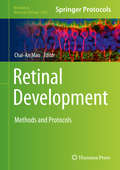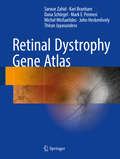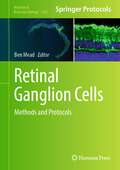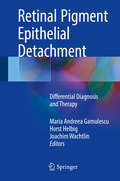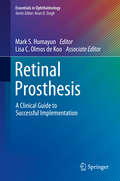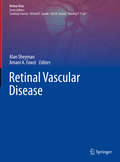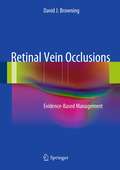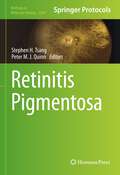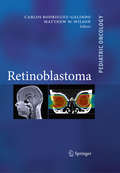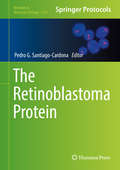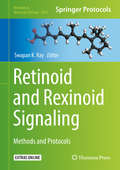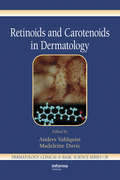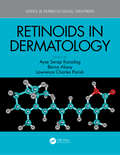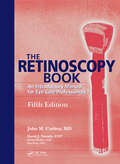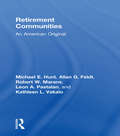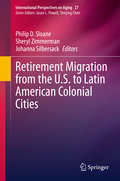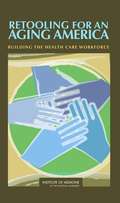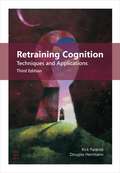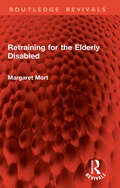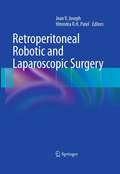- Table View
- List View
Retinal Development: Methods and Protocols (Methods in Molecular Biology #2092)
by Chai-An MaoThis volume details commonly used molecular and cellular techniques and specialized methodologies for studying retina neuronal subtypes and electrophysiology. Chapters describe techniques for anatomical studies of retinal ganglion cell morphology, gap-junction-mediated neuronal connection, multi-electrode array recording on mouse retinas, and paired recording to study the electrical coupling between photoreceptors. Written in the highly successful Methods in Molecular Biology series format, chapters include introductions to their respective topics, lists of the necessary materials and reagents, step-by-step, readily reproducible laboratory protocols, and tips on troubleshooting and avoiding known pitfalls. Authoritative and cutting-edge, Retinal Development: Methods and Protocols aims to provide readers with a set of practical experimental tools to study retinal development, regeneration, and function of mature retinal neurons. Many of the protocols and strategies described in one organism can be easily adapted to applications in different model systems.
Retinal Dystrophy Gene Atlas
by Sarwar Zahid Kari Branham Dana Schlegel Mark E. Pennesi Michel Michaelides John Heckenlively Thiran JayasunderaClassically, photo atlases of retinal dystrophies have been divided into sections that describe and depict a particular retinal finding or disease, after which a differential diagnosis of potential diseases or mutated genes is provided. However, given the rapid improvement in molecular diagnostics, and the exponential increase in our understanding of the phenotypes caused by each mutated gene, the paradigm has changed. Physicians are now more interested in the variable expressivity associated with mutations in each individual gene. Therefore, Retinal Dystrophy Gene Atlas catalogs the different phenotypes that have been reported with each mutated gene. Each section describes a gene and its known clinical phenotypes and features of disease, along with retinal photos of affected patients. Written by prominent retinal dystrophy specialists from the largest dystrophy centers worldwide, Retinal Dystrophy Gene Atlas contains more than 80 chapters, each of which describes the clinical and photographic manifestations of a specific gene. The chapters include stunning clinical color photographs of the retina, autofluorescence imaging, electrophysiologic findings, and cross-sectional imaging. Retinal Dystrophy Gene Atlas serves as a resource to aid genetic diagnosis in patients with retinal dystrophies.
Retinal Ganglion Cells: Methods and Protocols (Methods in Molecular Biology #2708)
by Ben MeadThis collection provides methods and techniques employed when culturing, manipulating, quantifying, and functionally assessing retinal ganglion cells (RGCs), vital for better understanding various ocular diseases and for developing novel therapies. The book features exhaustive and detailed protocols for the study of RGCs at both the in vitro and in vivo level, including the culture of rodent and human cells, and immunohistochemical, morphological, and functional assessments of various in vivo models of RGC death. Written for the highly successful Methods in Molecular Biology series, chapters include introductions to their respective topics, lists of the necessary materials and reagents, step-by-step and readily reproducible laboratory protocols, and tips on troubleshooting and avoiding known pitfalls. Authoritative and practical, Retinal Ganglion Cells: Methods and Protocols serves as an ideal guide to these important cellular features of the central nervous system and the many traumatic and degenerative blinding diseases that affect them.
Retinal Optical Coherence Tomography Image Analysis (Biological and Medical Physics, Biomedical Engineering)
by Xinjian Chen Fei Shi Haoyu ChenThis book introduces the latest optical coherence tomography (OCT) imaging and computerized automatic image analysis techniques, and their applications in the diagnosis and treatment of retinal diseases. Discussing the basic principles and the clinical applications of OCT imaging, OCT image preprocessing, as well as the automatic detection and quantitative analysis of retinal anatomy and pathology, it includes a wealth of clinical OCT images, and state-of-the-art research that applies novel image processing, pattern recognition and machine learning methods to real clinical data. It is a valuable resource for researchers in both medical image processing and ophthalmic imaging.
Retinal Pigment Epithelial Detachment
by Maria Andreea Gamulescu Horst Helbig Joachim WachtlinThis excellently illustrated book offers detailed guidance on the differential diagnosis and therapy of detachment of the retinal pigment epithelium (PED), a frequently seen feature in various diseases of the eye. Introductory chapters discuss the anatomy, pathophysiology, and imaging of PEDs, highlighting how especially the increasing use of spectral domain OCT enables even small PEDs to be detected and followed over time. The diverse forms of PED are then described, with explanation of how they may hint at the underlying pathology or even be pathognomonic when considered in conjunction with other clinical features. New insights are provided into the characteristics of the various forms of PED, and predictors of complications - such as rip of the PED - are discussed. It is clearly explained how knowledge of the different types of PED and their underlying diseases can assist in creating an appropriate individualized follow-up and therapy scheme for each patient.
Retinal Pigment Epithelium in Health and Disease
by Alexa Karina Klettner Stefan DithmarThis book provides a contemporary resource on one of the major players in retinal diseases – the Retinal Pigment Epithelium (RPE). Throughout the book, the physiological and the pathological function of the RPE are covered on equal terms, to help readers to understand the RPE as a whole. Moreover, the development of RPE in diagnostics and therapy are covered, as well as some practical knowledge about RPE experimental models. Retinal Pigment Epithelium in Health and Disease highlights new findings of RPE research and includes the state-of-the-art knowledge of each RPE topic presented. This important feature sets this book apart from other publications, with the chapters following a design which leads from the general to the specific, to give a precise collection of the facts known. The chapters are written by well-known experts that are currently active in the field as consultants, basic scientists, and group leaders, providing expert guidance on the current aspects and future outlooks of this topic.
Retinal Prosthesis: A Clinical Guide to Successful Implementation (Essentials in Ophthalmology)
by Lisa C. Olmos de Koo Mark S. HumayunIntended as a useful and practical guide primarily oriented toward ophthalmic practitioners involved in retinal prosthesis implantation and post-operative visual rehabilitation, this book focuses on the Argus II Retinal Prosthesis and its revolutionary incorporation into the practice. The reader will get an update on patient selection, expected visual outcomes, surgical implantation techniques, and post-operative visual rehabilitation. Retinal Prosthesis - A Clinical Guide to Successful Implementation is written in a clear and concise manner and includes diagrams and high quality photographs to demonstrate best practices in surgical techniques and desired outcomes. Covering topics such as history of retinal prostheses, bioengineering considerations, clinical therapies, and other therapies and future directions, this book is written for practicing ophthalmologists, residents, and medical students interested in retinal implants.
Retinal Vascular Disease (Retina Atlas)
by Alan Sheyman Amani A. FawziThis atlas extensively covers numerous aspects of retinal vascular disease, e.g. topics in retinal and vascular imaging ranging from common diseases such as diabetic and hypertensive retinopathy to rarer entities including sickle cell retinopathy and Coats disease. It primarily focuses on the imaging of these disorders, while also discussing various therapies and management decisions. Retinal Vascular Disease is one of nine volumes in the series Retina Atlas. The series offers a global perspective on vitreoretinal diseases, covering imaging basics, retinal vascular disease, ocular inflammatory disease, retinal degeneration, surgical retina, macular disorders, ocular oncology, pediatric retina and trauma. In nine volumes and over 100 chapters, Retina Atlas offers comprehensive and validated information on retinal disorders.
Retinal Vein Occlusions
by David J. BrowningAfter diabetic retinopathy, the varieties of retinal vein occlusion constitute the most prevalent category of retinal vascular disease. For macular edema associated with central retinal vein occlusion (CRVO), no effective therapy existed until 2009, despite decades of research and failed pilot therapies. This comprehensive, illustrated text integrates recent advances in treatments with the parallel progress in understanding of disease mechanisms. Complete with case studies, this text is perfect for retina specialists, ophthalmologists, optometrists, and residents and fellows in these fields.
Retinitis Pigmentosa (Methods in Molecular Biology #2560)
by Stephen H. Tsang Peter M. J. QuinnThis volume details the history of Retinitis Pigmentosa and current treatment options. Chapters guide readers through CRISPR, gene therapy, stem cell therapy, next-generation sequencing methods, gene editing, and translational applications of other therapies to the treatment of Retinitis Pigmentosa. Written in the successful Methods in Molecular Biology series format, chapters include introductions to their respective topics, lists of the necessary materials and reagents, step-by-step, readily reproducible protocols, and notes on troubleshooting and avoiding known pitfalls. Authoritative and cutting-edge, Retinitis Pigmentosa aims to be a useful practical guide to researches to help further their study in this field.
Retinoblastoma
by Matthew W. WilsonTreatment of retinoblastoma has evolved at a significant speed over the last two decades; ocular salvage approaches are now at the core of modern treatments, and assessment of visual and functional outcomes has become a priority. New discoveries in retinoblastoma biology are leading the way to the development of targeted therapies that could revolutionize our current approaches to the treatment. In this book, experts address all the important aspects of research and therapy - from biology to epidemiology to treatment. Retinoblastoma will provide a single source for the diagnosis and care of children with this malignancy.
The Retinoblastoma Protein
by Pedro G. Santiago-CardonaThis volume covers the mechanisms of pRb inactivation detailing repressive mechanisms commonly associated to cancer, and representative of the experimentally relevant tests used in the establishment of cancer diagnosis and prognosis. Chapters contain protocols and in-depth discussions for commonly used experimental approaches to assess the status and function of components of the pRb pathway, including pRb itself, in cell lines and biological samples.Written in the highly successful Methods in Molecular Biology series format, chapters include introductions to their respective topics, lists of the necessary materials and reagents, step-by-step, readily reproducible laboratory protocols, and tips on troubleshooting and avoiding known pitfalls.Authoritative and practical, The Retinoblastoma Protein aims to serve as a guide to assist molecular cancer biologists in their search for understanding of the molecular functions of this preeminent tumor suppressor.
Retinoid and Rexinoid Signaling: Methods and Protocols (Methods in Molecular Biology #2019)
by Swapan K. RayThis volume explores the latest synthetic procedures for producing receptor-specific retinoids and rexinoids, molecular biology methods, and new technologies to demonstrate the therapeutic activities of molecules. The chapters in this book cover topics such as lentiviral delivery of shRNA constructs into acute promyelocytic leukemia cells for ATRA induced differentiation and autophagy; methods to analyze RAR signaling in colorectal cancer cells; differentiation of primary myoblasts by using RXR agonist; methodology for analyzing effects of retinoid treatment on nervous system development and larval swimming behavior; and protocols for assessment of autophagic flux in ATRA treated 2D and 3D breast cancer cultures. Written in the highly successful Methods in Molecular Biology series format, chapters include introductions to their respective topics, lists of the necessary materials and reagents, step-by-step, readily reproducible laboratory protocols, and tips on troubleshooting and avoiding known pitfalls.Cutting-edge and comprehensive, Retinoid and Rexinoid Signaling: Methods and Protocols is a valuable resources for graduate students, postdoctoral fellows, and principal investigators who are interested in further exploring the signaling mechanisms of these molecules in their specific preclinical models.
Retinoids
by Gabriel H. Travis Hui SunNew and exciting biological functions are still being discovered for vitamin A derivatives, including the vast number of physiological activities of retinoids. In Retinoids: Methods and Protocols, expert researchers in the field present the most recent technical tools with diverse techniques for both in vitro and in vivo studies. Combining biochemical, biophysical, and cell biological techniques, the book addresses topics such as the detection and quantitation of retinoids using HPLC, mass spectrometry, and fluorescence, fluorescence anisotropy of retinol binding protein, cell culture models for studying retinoid transport and the role of retinol in embryonic stem cell culture, as well as many other detailed procedures. Written in the highly successful Methods in Molecular BiologyTM series format, chapters include introductions to their respective subjects, lists of the necessary materials and reagents, step-by-step, readily reproducible laboratory protocols, and notes highlighting tips on troubleshooting and avoiding known pitfalls. Authoritative and cutting-edge, Retinoids: Methods and Protocols seeks to aid beginning and experienced researchers from widely varied fields in the search to uncover even more vital aspects of vitamin A's impact on the human body.
Retinoids and Carotenoids in Dermatology (Basic and Clinical Dermatology)
by Anders Vahlquist Madeleine DuvicThis up-to-date reference describes how retinoids and carotenoids function in the skin and how they can be utilized to prevent and treat a wide variety of skin diseases, as well as advance biomedical research in relation to cancer treatment and immunology. Providing an in-depth update on the pharmacology, pharmacodynamics, and new applications of
Retinoids in Dermatology (Series in Dermatological Treatment)
by Lawrence Charles Parish Ayse Serap Karadag Berna AksoyThis up-to-date reference on the use of retinoids in dermatology presents how retinoids function in the skin, how they can best be used to treat and prevent various skin diseases, and how they can be monitored effectively. The text will provide an in-depth update on the pharmacology, clinical use, side effects, and follow-up of retinoid therapy in dermatology. This source also addresses topics related to retinoid use in special circumstances, such as vulnerable populations, concomitant surgery, and aesthetic procedures.
Retinopathy of Prematurity
by S. Paola Dorta B. Andrés KychenthalThis clinically oriented book is devoted to the diagnosis and treatment of retinopathy of prematurity (ROP), a leading cause of childhood blindness. World-renowned experts in the field discuss epidemiologic and pathogenic aspects of the disease. The staging and classification of ROP are explained in detail, and guidance is provided on appropriate anesthesia. The state of the art in imaging of ROP is described and illustrated, with coverage of the advances in ophthalmic imaging technology and telemedicine that have revolutionized pediatric retinal examinations and contributed significantly in elucidating the pathophysiology of ROP and improving diagnosis and treatment. Treatment indications and therapeutic alternatives, including the use of antiproliferative drugs, are addressed in separate chapters, supplying the reader with the most up-to-date knowledge in the field.
The Retinoscopy Book: An Introductory Manual for Eye Care Professionals
by John M. CorboyFor over 25 years, The Retinoscopy Book: An Introductory Manual for Eye Care Professionals has been the only basic instruction manual designed specifically to teach the art of clinical retinoscopy. This best-selling classic has been updated and revised to include the latest changes involving the retinoscope, and to meet the developing needs of students in ophthalmology and optometry. Sections on minus cylinders, concave mirror retinoscopy for high refractive errors, and a catalog of instruments have been expanded to reflect the most recent innovations. New sections on retinoscopy after refractive surgery and instrument maintenance are unique to this fifth edition.This text is designed to supplement the Joint Commission on Allied Health Personnel in Ophthalmology (JCAHPO) instruction courses for technicians or to facilitate a do-it-yourself training program for ophthalmology residents, ophthalmic technicians, optometry students, and other eye care professionals in training. Figures and illustrations supplement time-tested exercises to facilitate learning. The user-friendly format prevalent throughout the text enables students to develop a complete understanding of the retinoscope and its many uses.
Retirement Communities: An American Original
by Michael E Hunt Allan G Feldt Robert W Marans Kathleen L Vakalo Leon A PastalanThis insightful book focuses on state-of-the-art retirement communities in the United States today. Experts from the fields of urban planning, architecture, and aging present in-depth profiles of a variety of retirement communities. The changing function and character of retirement communities--resulting from changes in supply and demand, alternate lifestyles, and other environmental needs of an ever-increasing aging population--are explored. The timely discussions in this useful resource offer insights into the relative strengths and weaknesses of various types of retirement communities with respect to the varying needs, abilities, and desires of older people.
Retirement Migration from the U.S. to Latin American Colonial Cities (International Perspectives on Aging #27)
by Sheryl Zimmerman Philip D. Sloane Johanna SilbersackThis book provides a comprehensive overview of a growing phenomenon in migration: retired Americans moving to Latin America. Through in-depth profiles of two of the most popular destinations – Cuenca, Ecuador and San Miguel de Allende, Mexico, the book provides a unique commentary on the social forces shaping this new diaspora and its impact on the settings to which retirees relocate. Sections of the book address the lives and activities of retirees themselves; their impact on real estate, business development, and gentrification within historic cities; the availability and access to medical and long-term care services; and the role of governmental policies in attracting immigrant retirees and shaping their societal impact. Concluding sections provide guidance for potential retirees and for cities and countries interested in attracting these new immigrants while minimizing adverse impact on local culture and quality of life. Carefully researched and extensively illustrated with photographs, maps, figures, and tables, the book serves as an important new resource for scientists and policy makers, as well as for baby boomers who have retired abroad or are considering doing so.
Retooling For An Aging America: Building The Health Care Workforce
by Institute of Medicine of the National AcademiesAs the first of the nation's 78 million baby boomers begin reaching age 65 in 2011, they will face a health care workforce that is too small and woefully unprepared to meet their specific health needs. Retooling for an Aging America calls for bold initiatives starting immediately to train all health care providers in the basics of geriatric care and to prepare family members and other informal caregivers, who currently receive little or no training in how to tend to their aging loved ones. The book also recommends that Medicare, Medicaid, and other health plans pay higher rates to boost recruitment and retention of geriatric specialists and care aides. Educators and health professional groups can use Retooling for an Aging America to institute or increase formal education and training in geriatrics. Consumer groups can use the book to advocate for improving the care for older adults. Health care professional and occupational groups can use it to improve the quality of health care jobs.
Retraining Cognition: Techniques and Applications (Third Edition)
by Rick Parenté Douglas J. HerrmannTextbook on cognitive rehabilitation therapy, for psychology and rehabilitation students. Discusses therapeutic methods and their theoretical foundations in cognitive psychology, neuropsychology, and speech.
Retraining for the Elderly Disabled (Routledge Revivals)
by Margaret MortMany elderly patients have long-term physical disability and in order for them to maintain a certain level of independence either in hospital or in the community, great attention must be paid to devising programmes to overcome problems and enhance residual abilities.Originally published in 1985, the programme described in this book had developed over the previous 25 years at the Royal Newcastle Hospital in Australia. It grew in response to the practical needs of patients who, having been treated by conventional means, were left with residual disabilities to a degree that their successful return to the community was jeopardised. The retraining programme described is a problem-solving process, coordinated under one director, combined with close teamwork between staff, the patient and relatives. Throughout, attention is paid to social and psychological factors as well as physical problems, when discussing physical retraining methods involving the repetition of routine movements.
Retrolental Fibroplasia and Autistic Symptomatology: An Investigation into Some Relationships Among Neonatal, Environmental, Developmental and Affective Variables in Blind Prematures
by Joan B. ChaseIn this monograph, based on a study of 263 subjects with RLF (Retrolental Fibroplasia-- an eye condition caused by excessive incubator oxygen), the author examines selected variables which may significantly affect subsequent development.
Retroperitoneal Robotic and Laparoscopic Surgery
by Hitendra R.H. Patel Jean V. JosephRetroperitoneal Robotic and Laparoscopic Surgery provides urologists with an easy way to learn the extraperitoneal alternative when performing laparoscopic or robot assisted procedures. There are significant technical differences between intra-peritoneal and retroperitoneal surgery. There are occasions, particularly with a history of prior intra-abdominal surgeries, when the retroperitoneal route is not only less invasive, but provides an efficient and effective way of performing the operation. Retroperitoneal Robotic and Laparoscopic Surgery is a step-by-step guide of all extraperitoneal laparoscopic and robot assisted procedures. This book will support beginners in making the transition from open extraperitoneal to laparoscopic or robotic extraperitoneal procedures. It is also a valuable reference tool to further assist the intermediate and advanced laparoscopist to expand their skills working in the extraperitoneal space.
